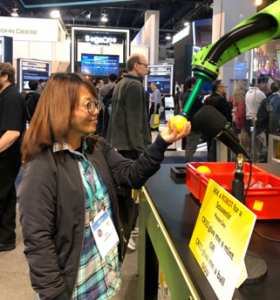
AIは未来のビジネスに役立つものであり、すでに導入されているものもあります。AIを導入し、展開するためにはどこから始めれば良いのか、そして一つのユースケースの重要性について考えていきましょう。
AIはすでにビジネスの一部となっています。GARTNER社の調査報告では 37%の組織が何らかの形でAIを使っています。過去4年でAIを使う企業は270%も増えています。昨年度だけでも3倍になりました。
今のAI技術は非常にパワフルです。テスラのCEOを務めるイーロン・マスクの新しいベンチャーNeuralinkは早くても2020年には貴方の知識とAIをマージできます。AIの新しい能力に胸が高鳴る一方で、AIは成果を出すための新しいリソースであることを忘れてはなりません。
私は今まで沢山のビジネスリーダーにAIの実用化をどう成功させるかを話してきました。その中で共通していたことは、AIの実用化は一つのユースケースからはじまる、ということです。さもないと、AI技術を少しかじっただけにとどまり、結果を出せないでしょう。子供だましに終わるか、ビジネスの成功に繋がるかは、ユースケースが鍵を握っています。
AIを導入する時に、最初に明確なユースケースを定義します。シンプルなものでも構いません。このユースケースから、どのような“ツール”が必要で、どう試し、展開していくかがわかります。
CES2020で紹介された技術を例をいくつか見ていきましょう。
* CES(consumer electric show)米ラスベガスで開催される世界最大級の技術・家電見本市

出典:CES Technologies Association ウェブサイト
Bosch社のVirtual VisorはLCDパネルにリンクし、ドライバーの顔に映る太陽の影をカメラで追跡します。AIでカメラとドライバーの位置を合わせ、目・鼻・口といった顔のパーツを認識し、顔に映る太陽の影を識別するのです。また、アルゴリズムでドライバーの視線を分析し、ドライバーの目に光が当たる部分だけを暗くすることもできます。
Bosch Virtual Visorは「ユースケースからスタート」する良い例です。AIなどの技術を使って、昔からある問題を解決し、安全で快適なドライブを実現できます。

Photo: Jun@CES Fanuc booth
もう一つの例は、ロボティクスの大手Fanucです。CESの会場で、私がFanucのロボットに「ボールをください」と声を掛けたところ、ロボットはちゃんと箱からボールを取り、私に渡してくれました。このケースでは、FanucはAIを使ってロボットのトレーニングをしています。
「AIの導入以前、ロボットのトレーニングは試行錯誤の繰り返しで、時間もかかり、とても面倒でした」、とFanucのロボットビジネスリーダーは語っていました。
Fanucの新しいAIツールが導入されたことにより、ロボットのトレーニングのプロセスが簡単になりました。箱に入っているたくさんのパーツの写真がスクリーンに映し出されるので、トレーニングスタッフはこの中から取り出すべきものを選択します。子供におもちゃの整理のしかたを教えるのと同じです。たったこれだけでトレーニングが完了するため、同時に多数のロボットをトレーニングすることも可能です。
ユースケース作りはどのようにスタートすれば良いでしょう?私はいつもクライアントと自分自身にこう問います。
• どのような問題を解決したいですか?
• どのようなビジネスの成果を出したいですか?
• 問題解決、成果を出すために、どのようなツールが必要でしょうか?
いつか私もAIとともにユースケースを定義したいですね。
Jun S Hibbard – シリコンバレーから皆様にArtificial Intelligence (AI)トレンド、ベストプラクティス、専門家の声をお届けします。ご感想、聞きたいトピックスなどありましたら是非ともご連絡ください。
日本語訳:Masaki
早稲田大学教育学部卒業。ライター、編集、翻訳アシスタントとして様々なプロジェクトに携わる。
(English)
AI is the future for business and somewhat already here. Here are a few thoughts on how to start on this journey and the importance of a single use case.
Artificial Intelligence (AI) is already part of our business. Gartner survey shows 37% of organizations have Implemented AI in some form. The number of enterprises that implement artificial intelligence (AI) grew 270% in the past four years and tripled in the past year, according to the Gartner, Inc. (Jan. 2019)
AI technology is now extra powerful. Tesla’s Elon Musk could merge your brain with AI as soon as 2020 through his new startup Neuralink. Our eyes will get shiny when we see new capability of AI, and we shall remind ourselves that AI is a new resource to help drive business outcomes.
I spend a lot of time talking to professionals about how to drive successful AI implementation. One common good practices of AI implementation is to start with one use case. Otherwise you will bite off to much technology and not be able to drive this outcome. This first step will lead your organization to a meaningful result – you will then not stop at adding one “AI-toy”
When you bring AI to your organization, the first thing is to define a clear use case, often times, a simple use case. With this use case, we will be able to understand what “tools” you need, to prototype, test, then scale.
Here are some use case examples from CES2020:
• Bosch concept virtual visor: Bosch Virtual Visor links an LCD panel with a driver or occupant-monitoring camera to track the sun’s casted shadow on the driver’s face. The system uses artificial intelligence to locate the driver within the image from the driver-facing camera. It also utilizes AI to determine the landmarks on the face ‒ including where the eyes, nose and mouth are located ‒ so that it can identify shadows on the face. The algorithm analyzes the driver’s view, darkening only the section of the display through which light hits the driver’s eyes. The rest of the road is more clear than ever.
The Bosch Virtual Visor is a great example of start with a use case, bring AI and other technologies, to solve a “old” problem, and deliver a result: safety and comfort for drivers.
• Another example is well known Industrial robotics giant Fanuc. At CES, I “talked” to a Fanuc robotics arm to pick up a ball from a bin. The robot was very smart and completed the mission. In this case, the use case for Fanuc is to make robots easier to train.
“Making these rules in the past meant having to through a lot of iterations and trial and error. It took time and was very cumbersome,” said Dr. Kiyonori Inaba, the head of Fanuc Corporation’s Robot Business Division.
This is where Fanuc’s new AI-based tool comes in. It simplifies the training process so the human operator just needs to look at a photo of parts jumbled in a bin on a screen and tap a few examples of what needs to be picked up, like showing a small child how to sort toys. This is significantly less training than what typical AI-based vision sensors need and can also be used to train several robots at once.
How to start a use case? I will ask myself and clients:
• What problem you want to solve?
• What business outcome you want to drive?
• What new capabilities and tools you will need to solve the problem or achieve the goal?
One day, I will like to work with AI to help define more use cases – in the right business context.
Jun – Greeting from Silicon Valley, California! I am Jun and run a consulting firm to support Japanese companies that drive and create innovation solutions by leveraging technologies like AI.
Let me know your thoughts, topics you will like to know.
Jun S Hibbard
現在米国カリフォルニア シリコンバレーを拠点にし、シリコンベレーを始め、海外のベンチャー企業、新しい技術とビジネスモデルの情報を収集し、日本のクライアントと協力し、オープンイノベーションを推進しています。
<主な職歴>
現 (米)スマート イノベーションCEO
GE DigitalインダストリアルIoTパートナー新市場開拓事業部 部長
Ciscoアジアスマート事業部パートナー戦略 リーダー
ベンチャー eWingsTech 副社長
<教育と資格>
上海交通大学コンピュータ科学専攻 卒業
米国マサチューセッツ工科大学MIT AI(Artificial Intelligence)ビジネス戦略プログラム 修了